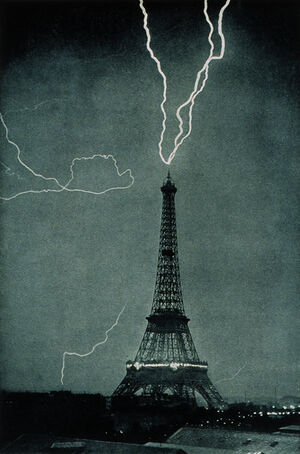Lightning (nonfiction): Difference between revisions
Jump to navigation
Jump to search
No edit summary |
|||
| Line 1: | Line 1: | ||
'''Lightning''' is a sudden electrostatic discharge during an electrical storm between electrically charged regions of a cloud (called intra-cloud lightning or IC), between that cloud and another cloud (CC lightning), or between a cloud and the ground (CG lightning). | [[File:Lightning_striking_the_Eiffel_Tower_-_NOAA.jpg|thumb| Lightning striking the Eiffel Tower, June 3, 1902, at 9:20 P.M. This is one of the earliest photographs of lightning in an urban setting In:"Thunder and Lightning", Camille Flammarion, translated by Walter Mostyn Published in 1906.]]'''Lightning''' is a sudden electrostatic discharge during an electrical storm between electrically charged regions of a cloud (called intra-cloud lightning or IC), between that cloud and another cloud (CC lightning), or between a cloud and the ground (CG lightning). | ||
== Description == | == Description == | ||
Revision as of 11:52, 4 June 2016
Lightning is a sudden electrostatic discharge during an electrical storm between electrically charged regions of a cloud (called intra-cloud lightning or IC), between that cloud and another cloud (CC lightning), or between a cloud and the ground (CG lightning).
Description
The charged regions in the atmosphere temporarily equalize themselves through this discharge referred to as a strike if it hits an object on the ground, and a flash if it occurs within a cloud.
Lightning causes light (nonfiction) in the form of plasma, and sound in the form of thunder.
Lightning may be seen and not heard when it occurs at a distance too great for the sound to carry as far as the light from the strike or flash.
Nonfiction cross-reference
Fiction cross-reference
External links
- Lightning @ Wikipedia
